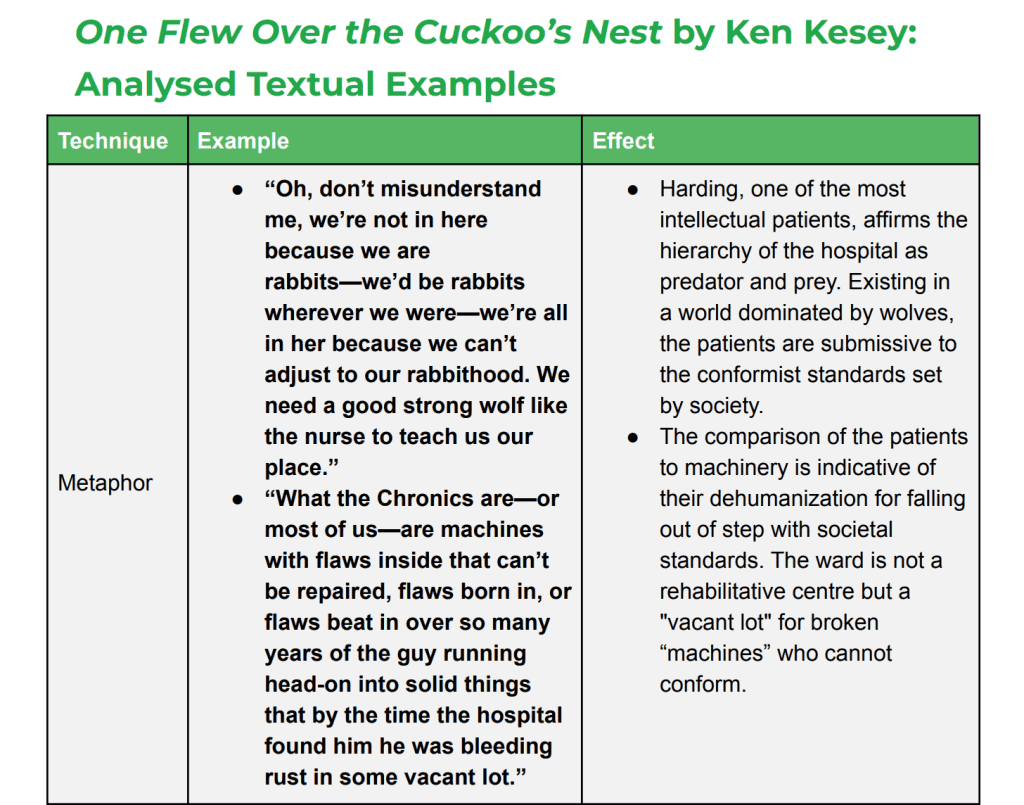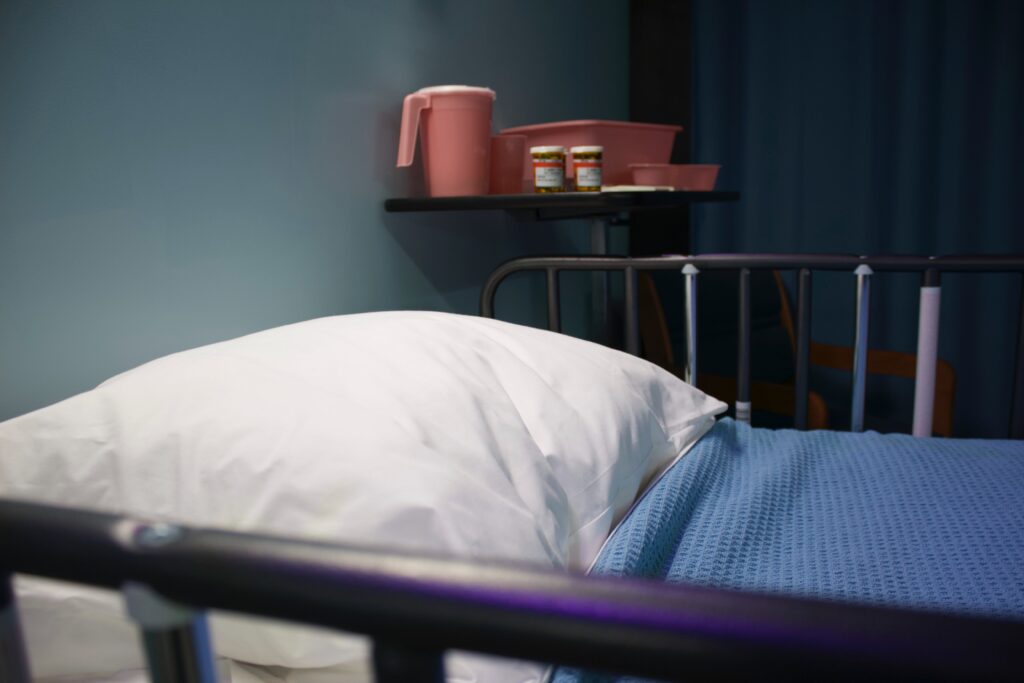Are you studying the book ‘One Flew Over the Cuckoo’s Nest’ for English but have no idea how to come up with an analysis? We’ve got you — we’re going to take you through a summary, the key characters and themes of One Flew Over the Cuckoo’s Nest.
PLUS, we’ll provide you with a sample analysis table (also called a TEE table), and a sample paragraph so you know exactly how to structure yours.
So, what are you waiting for? It’s time to ace your analysis of One Flew Over the Cuckoo’s Nest!
One Flew Over the Cuckoo’s Nest Book Summary
Key Book Characters in One Flew Over the Cuckoo’s Nest
Context
Themes Explored in One Flew Over the Cuckoo’s Nest
One Flew Over the Cuckoo’s Nest Book Analysis
One Flew Over the Cuckoo’s Nest Book Summary
One Flew Over the Cuckoo’s Nest is written in the literary fiction genre and explores the terrors in the America’s treatment of mental illness.
With its graphic depictions of punishment, One Flew Over the Cuckoo’s Nest’s book age rating is 17+!
McMurphy Transfers to Oregon Psychiatric Hospital
Set in Oregon psychiatric hospital, the novel is narrated by anti-hero Chief Bromden, a half-Indian schizophrenic patient who pretends to be deaf and mute.
The book begins with the arrival of Randle McMurphy, who has faked insanity to transfer from the Pendleton Work Farm. He is highly boisterous and introduces the patients to gambling, encouraging them to rebel against the strict regime of Nurse Ratched, the head administrative nurse.
In One Flew Over the Cuckoo’s Nest Chapter Seven, the plot ramps up when Bromden goes to sleep without taking his red pill. He witnesses all sorts of schizophrenic hallucinations — the ward sinks into itself and becomes a factory where Blastic is cut open.
McMurphy’s Rebellion
The other patients warn McMurphy that Ratched rules the hospital with an iron fist, but he ignores their concerns, opting to disobey her rules and disrupt her power instead. He makes a bet with the patients that he can make Ratched lose her temper within a week.
After a series of antics, culminating in a protest with the other patients about watching the World Series, Ratched finally loses her temper. McMurphy revels in his victory.
Realising Ratched’s Power
Instead of being sent to the Disturbed Ward, Ratched decides to keep McMurphy in the regular ward to show the other patients that he is as cowardly as them. McMurphy soon realises that being involuntarily committed means that Ratched has the power to determine whether he is free to go.
He begins to submit to her rules, but by this time, the other patients see him as a rebellious leader and are confused at his newfound behaviour. Charles Cheswick becomes disappointed and drowns in the pool in a possible suicide.
The Fishing Trip
McMurphy arranges a fishing trip for him and some of the other patients. McMurphy plans to help Billy Bibbit lose his virginity by sneaking a prostitute into the ward during the trip.
On their return, McMurphy and Chief get into a fight with some of the aides while defending George Sorensen. They are sent to the Disturbed Ward and receive electroshock therapy.
Party in the Ward
Despite his weakened state, McMurphy smuggles two prostitutes with alcohol into the ward, and they throw a party. McMurphy plans to escape before the morning, but he falls asleep in his drunken state without cleaning up the ward.
Finding Billy and the prostitute together, Ratched threatens to tell Billy’s mother, and he commits suicide after an emotional breakdown. Enraged, McMurphy rips Ratched’s shirt open and attempts to strangle her to death.
Following his attack, McMurphy is sent to the Disturbed ward and receives a lobotomy. He returns to the ward as a vegetable, and Chief smothers him to death out of mercy. He breaks through a window and escapes from the hospital.
Key Book Characters in One Flew Over the Cuckoo’s Nest
Chief Bromden
The novel’s narrator, Chief is a long-time patient who has paranoid schizophrenia and drug-induced hallucinations.
He pretends to be deaf and mute so everyone can ignore him, but he slowly emerges out of his shell by McMurphy’s defiance against the patient’s control. In the end, Chief suffocates McMurphy in the act of mercy and escapes from the hospital.
Randle McMurphy
Transferred from a prison work farm, McMurphy fakes his madness to manipulate the system, challenging Nurse Ratched’s rigid policies.
Intent on showing the other patients how to enjoy their lives, McMurphy inspires confidence to express their emotions and rebel against authority. McMurphy embodies complete non-conformity, yet his lobotomy at the end of the novel strips away his sanity and autonomy.
Nurse Ratched
The tyrannical Head Nurse, Ratched is an oppressive force who rules the ward with coldness and cruelty. As a former army nurse, Ratched performs her job without emotion and demands complete submission from her patients.
McMurphy successfully challenges her power throughout the novel, yet his eventual lobotomy marks her revenge.
Context of One Flew Over the Cuckoo’s Nest
Published in 1962, Ken Kesey’s ‘One Flew Over the Cuckoo’s Nest’ is emblematic of the turbulence of the 1960s during the Civil Rights Movement and the rise of deinstitutionalisation. Through the setting of a mental ward, the novel is rooted in American post-war cultural shifts and heavily deals with anti-authoritarian and institutional sentiments.
The novel is narrated by “Chief” Bromden, a Native American patient who has been in the hospital for several years and who pretends to be deaf and dumb to avoid interaction with the staff. The story centres around the arrival of a new patient, Randle McMurphy, a charming and rebellious criminal who is transferred from a prison work farm to the hospital after faking insanity to avoid hard labor.
McMurphy’s arrival and his subsequent clashes with the authoritarian Nurse Ratched, who is in charge of the ward, bring about a wave of change among the patients, who begin to assert their individuality and resist the oppressive environment in which they are confined.
Through the eyes of Chief Bromden, the reader witnesses McMurphy’s struggle against the system and the toll it takes on him and the other patients, ultimately leading to a tragic ending. The novel has been praised for its powerful social commentary on the treatment of mental illness and the role of institutions in society.
The rise of ‘anti-psychiatry’ during the 1960s reflects the changing mindset towards greater freedom for people with mental health conditions. The growing concerns about patients subjected to harsh treatment and risky medical interventions are evident in Kesey’s representation of the oppressive power imbalance between the staff and patients.
Themes Explored in One Flew Over the Cuckoo’s Nest
As a novel, several structural, contextual, and literary elements aid in deconstructing the significant themes of the text. One Flew Over the Cuckoo’s Nest’s use of narration, foreshadowing, conflict, motif, and symbolism all tie together to strengthen the fundamental ideas of dehumanisation and control by authoritarian figures and systems.
Below are some of the key themes from ‘One Flew Over the Cuckoo’s Nest’ that make for a strong starting point to structure your analysis:
Conformity and Individuality
The battle between conformity and individuality is a major theme that forefronts McMurphy’s refusal to let go of his individuality.
Opposed to the machinelike rigidity of the institution, McMurphy deprives Nurse Ratched of her inscrutable authority and works towards inspiring the other patients to regain their individuality and challenge her control.
Power
The power struggle that ensues between Nurse Ratched and McMurphy is the symptom of rebellion against the overarching institutional authority that subordinates the patients.
Power manifests in explicit ways through the tyrannical orders of Nurse Ratched and the raucous disobedience of McMurphy, as well as implicitly through the gradual enlightenment that the patients experience throughout the novel, culminating in Chief’s escape from the hospital.
Sanity and Madness
Manipulating the idea of sanity to feign psychosis, McMurphy battles against authority figures who attempt to suppress the unpredictability of the human spirit, raising the question of what defines sanity. The patients often exhibit signs of sanity, while Nurse Ratched’s emotional outbursts mimic the characteristics of madness.
Sexuality
Centring Nurse Ratched as a forceful instrument of power, the emasculation and weakening of men by callous women is a recurrent theme throughout the novel. Many of the patients have experienced emotional turmoil in their relationships with women, and the repression of their sexuality is starkly opposed to McMurphy’s individuality and sexual expression.
One Flew Over the Cuckoo’s Nest Book Analysis in 3 Steps
A common mistake that students often make while attempting to answer their essay questions is beginning with their thesis. Instead of stressing about your thesis, you should use your analysis as the starting point!
Analysing your text is a great way to gain an in-depth understanding of its meaning before you begin to answer anything about it.
After you’ve analysed your text, you will be able to build on its themes and construct a strong thesis!
We’re going to walk you through the process of creating an analysis for One Flew Over the Cuckoo’s Nest in three simple steps!
Step 1: Choose your example(s)
When choosing your example, an important tip is to search for an excerpt that contains a technique. Techniques are essential to helping you dig deeper into what meaning the composer is trying to convey.
You can find a whole range of quotes from One Flew Over the Cuckoo’s Nest!
We have chosen to look at two quotes that characterise Nurse Ratched as an emotionless figure:
“… There’s no compact or lipstick or woman stuff, she’s got that bag full of a thousand parts she aims to use in her duties today—wheels and gears, cogs polished to a hard glitter, tiny pills that gleam like porcelain, needles, forceps, watchmakers’ piers, rolls of copper wire.”
and
“…Doctors, all ages and types, come and rise up in front of her with ideas of their own about the way a ward should be run, some with backbone enough to stand behind their ideas, and she fixes these doctors with dry-ice eyes day in, day out, until they retreat with unnatural chills.”
Step 2: Identify your techniques
When searching for a useful technique within your example, the best method is to identify a technique that enables you to uncover a deeper subtext of your work and elevate your argument and analysis.
Rather than referencing simple language techniques like alliteration and rhyme, try searching for techniques that unveil symbolic meanings like metaphors, motifs, allusions, and intertextuality.
We have identified 3 techniques in the two quotes above: hyperbole, symbolism, and metaphor.
It’s always better to try and find multiple techniques in your quotes rather than just one, so you can really show your marker just how great your analysis skills are!
Step 3: Write the analysis
When you write your analysis, the key focus should be on what effect the technique has. Simply labelling what technique you’re using is not analysing and will award you minimal marks. Technique labelling would look like this:
The hyperbole of Ratched’s handbag being “full of a thousand parts she aims to use in her duties today—wheels and gears, cogs polished to a hard glitter” is symbolic of her machine-like character. Her manipulative skill is shown in the metaphor of her fixing the doctors with “dry-ice eyes day in, day out, until they retreat with unnatural chills”.
Instead of labelling, we need to flesh out how each technique allows a closer reading of the text.
Firstly, the hyperbole is important as it exemplifies the persona of Ratched as a cold corporate tool that functions as an inscrutable cog in the institution. The symbolic lack of feminine products in her handbag reinforces Ratched’s inhumanness and power of emasculation.
The metaphor of her “dry-ice eyes” changing the minds of doctors demonstrates her manipulative ability to preserve control.
So if we included all that in our analysis, it looks like:
The hyperbole of Ratched’s handbag being “full of a thousand parts she aims to use in her duties today—wheels and gears, cogs polished to a hard glitter” conjures up industrial imagery that cements her status as a cold corporate tool. Ratched’s absence of femininity and sexlessness is a symbolic representation of her machine-like inhumanness and emasculating power that pervades her presence with the patients. Her manipulative skill to preserve control is demonstrated in the metaphor of her fixing the doctors with “dry-ice eyes day in, day out, until they retreat with unnatural chills.”
Step 4: Practise with sample essay questions
Even if you’ve written an incredible essay, if you don’t respond to the question or stimulus that you’re given in an exam, you could miss out on a Band 6.
Luckily for you, we’ve got plenty of practise questions on our resources page for you to use!
In Year 11? Here are 20 Reading to Write Practise Questions to get you started!
Need some help analysing other texts?
Aside from our guide on One Flew Over the Cuckoo’s Nest, you can check out other texts we’ve created guides for below (featuring characters, context, themes, a summary, and more):
- All the Light We Cannot See
- Lord of the Flies
- Hamlet
- Jane Eyre
- In Cold Blood
- Run Lola Run
- King Lear
- Mabo
- The Book Thief
- Macbeth
- Things Fall Apart
- Mrs Dalloway
Are you looking for some extra help with your book analysis of One Flew Over the Cuckoo’s Nest?
We have an incredible team of English tutors and mentors!
We can help you master your book analysis of One Flew Over the Cuckoo’s Nest by taking you through the summary, key characters and themes. Our expert English tutors will also help you ace your upcoming English assessments with personalised lessons conducted one-on-one in your home or online!
We’ve supported over 8,000 students over the last 11 years, and on average our students score mark improvements of over 20%!
To find out more and get started with an inspirational English tutor and mentor, get in touch today or give us a ring on 1300 267 888!
Ashley Sullivan is a Content Writer for Art of Smart Education and is currently undertaking a double degree in Communications (Journalism) and a Bachelor of Laws at UTS. Ashley’s articles have been published in The Comma and Central News. She is a film, fashion and fiction enthusiast who enjoys learning about philosophy, psychology and unsolved mysteries in her spare time.






